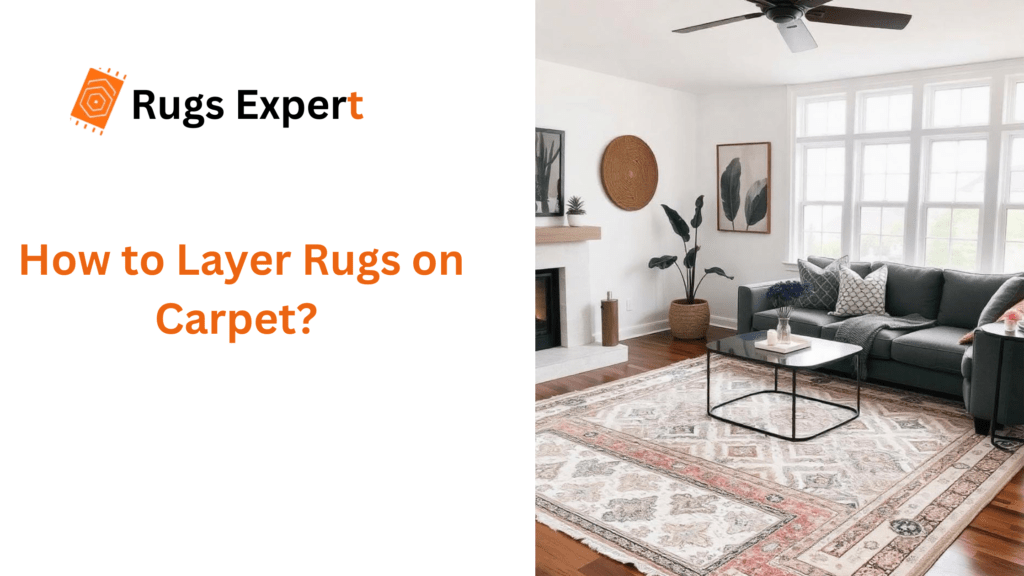
Imagine walking into a room that tells a story through its floor where textures intertwine, colors dance, and every step feels like a juicy experience. This is the magic of rug layering, an interior design technique that transforms ordinary carpeted spaces into extraordinary, personalized environments.
What is Rug Layering?
Rug layering is more than just placing one rug atop another; it’s an art form that combines functionality with aesthetic expression. By strategically positioning multiple rugs on a carpeted surface, you can:
- Create visual depth and interest
- Define specific zones within a room
- Add textural complexity
- Protect high-traffic carpet areas
- Express your unique design personality
“Rug layering is like painting with textiles. Each layer adds a new stroke of personality to your space.” – Emily Henderson, Interior Design Expert
Why Layer Rugs on Carpet?
While it might seem senseless to add rugs to an already covered floor, modern interior design has embraced this technique for several compelling reasons:
- Visual Complexity: Layered rugs break monotony and add visual intrigue
- Texture Variation: Different materials create sensory richness
- Space Definition: Rugs can help segment open-plan living areas
- Practical Protection: Additional layers shield the carpet from wear and tear
Understanding Rug Layering Foundations
Types of Rugs Perfect for Layering
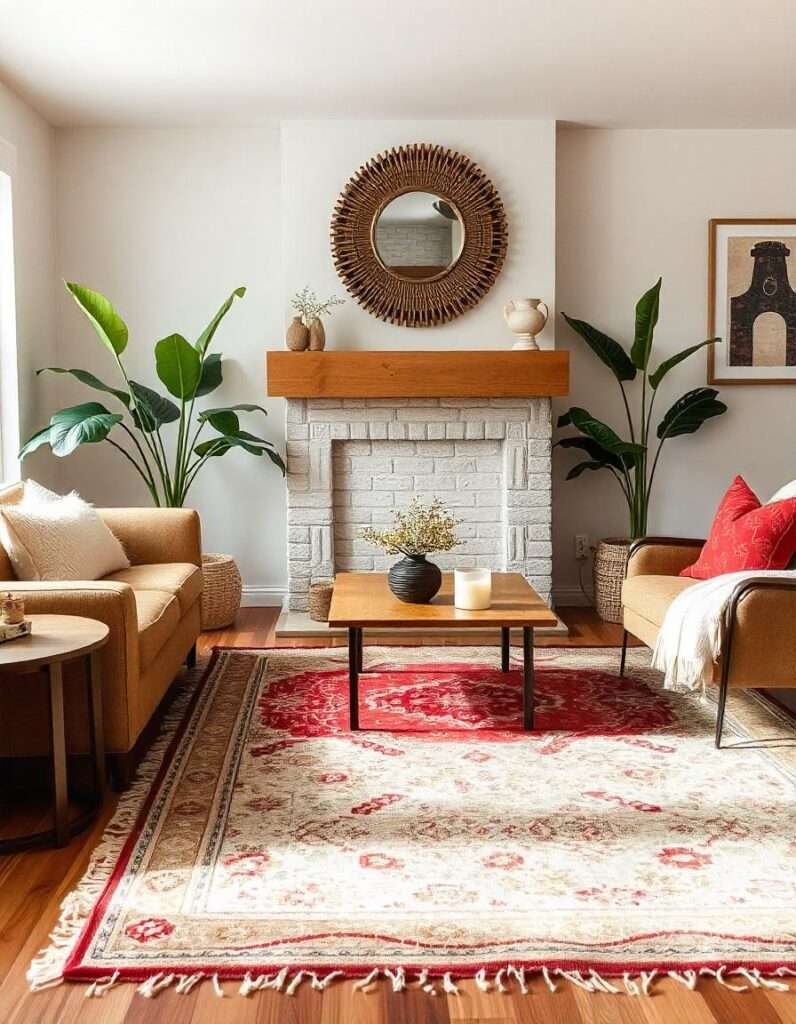
While layering, keep in mind that all rugs are created differently. Here are the most versatile options:
| Rug Type | Characteristics | Best For |
| Area Rugs | Large, rectangular | Living rooms, bedrooms |
| Runner Rugs | Long, narrow | Hallways, alongside beds |
| Accent Rugs | Small, decorative | Highlighting specific areas |
| Specialty Rugs | Unique patterns (Kilim, Persian) | Adding cultural flair |
Critical Carpet Considerations
Before diving into layering, assess your existing carpet:
- Pile Height: Low-pile carpets work best
- Color Palette: Choose complementary or contrasting colors
- Traffic Patterns: Consider wear and movement areas
- Slip Potential: Use proper gripping techniques
Pro Tip: Psychological Impact
Research in environmental psychology suggests that layered rugs can create a sense of comfort and personal territory. By strategically placing rugs, you’re not just decorating, you’re crafting psychological spaces that influence mood and perception.
Design Principles for Masterful Rug Layering: Transform Your Space with Expert Techniques
When learning how to layer rugs on carpet, understanding design principles is crucial for creating a cohesive, visually stunning interior that reflects your personal style and enhances your living space.
This section will dive deep into the art and science of rug layering, providing you with professional insights that will elevate your home’s aesthetic.
A. Color Theory and Coordination: Creating Harmonious Visual Landscapes
Color is the silent storyteller of interior design. And when layering rugs on carpet, it becomes your primary tool for creating depth, emotion, and visual interest. Understanding color relationships can transform a dull floor into a captivating design statement.
Layering Color Strategies for Maximum Impact
- Complementary Color Techniques
- Use color wheel principles to select rugs that enhance each other
- Create visual tension by pairing opposite colors
- Example: A deep blue rug layered over a warm terracotta carpet
- Monochromatic Layering
- Explore different shades and tones of the same color family
- Add depth through subtle color variations
- Creates a sophisticated, cohesive look
- Contrasting Color Strategies
- Bold combinations that make a dramatic statement
- Use the 60-30-10 color rule (60% dominant, 30% secondary, 10% accent)
- Ideal for modern and eclectic interior styles
B. Texture and Pattern Mixing: The Tactile Dimension of Rug Layering
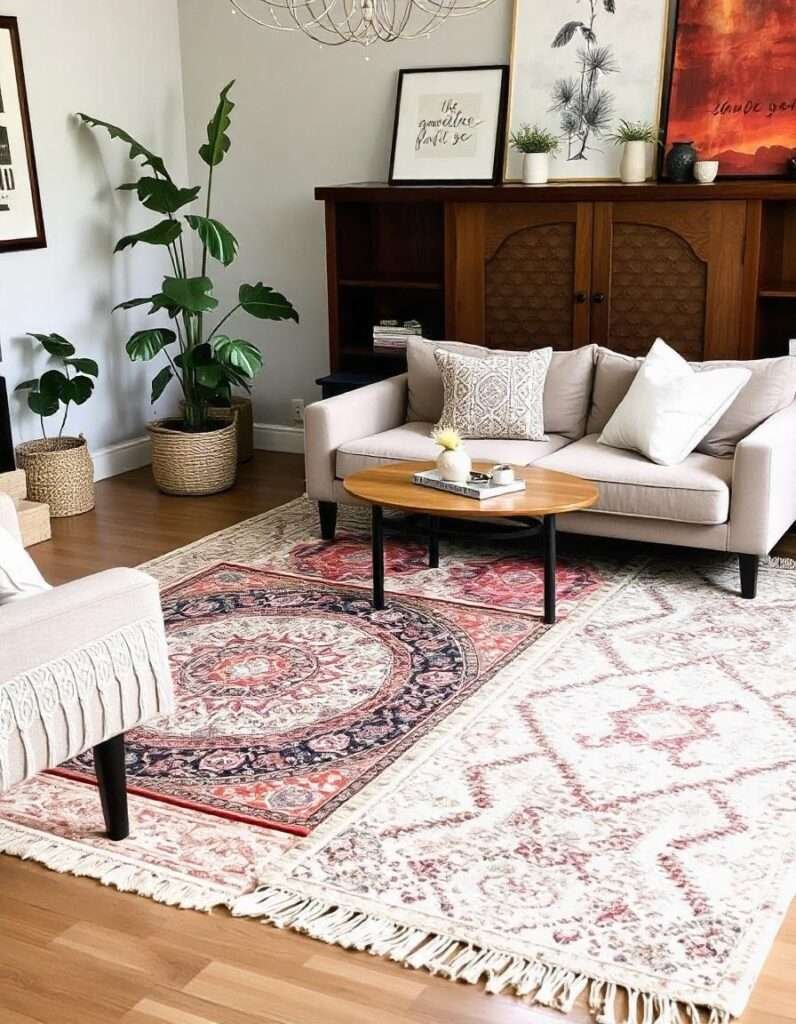
Texture is not just about touch. It’s about creating visual complexity and sensory richness in your living spaces. When layering rugs on carpet, texture becomes your secret weapon for adding depth and interest.
Texture Layering Principles
| Texture Type | Characteristics | Recommended Combinations |
| Smooth | Shiny, modern surfaces | Pair with textured, handwoven rugs |
| Plush | Soft, luxurious feel | Combine with flat-weave geometric patterns |
| Woven | Intricate, detailed | Layer over solid-colored base rugs |
| Natural Fibers | Organic, rustic | Mix with contemporary, minimalist designs |
Pattern Considerations for Successful Layering
- Scale and Proportion
- Balance large-scale patterns with smaller, more intricate designs
- Avoid overwhelming the space with competing patterns
- Use a neutral base rug to anchor complex patterns
- Visual Weight Distribution
- Distribute visual weight evenly across the room
- Use lighter patterns in larger areas
- Concentrate on detailed patterns in specific zones
C. Size and Placement Strategies: Precision in Rug Positioning
Mastering how to layer rugs on carpet requires understanding the mathematical and aesthetic principles of size and placement. It’s not just about throwing rugs together, it’s about creating intentional, harmonious arrangements.
Rug Size Ratio Guidelines
- Large Base Rug: 24-36 inches from wall, covering 70-80% of floor space
- Accent Rugs: 50-70% smaller than the base rug
- Runner Placement: Centered, with equal space on sides
Professional Tips for Flawless Rug Layering
- Always use rug pads to prevent slipping
- Consider room traffic patterns
- Experiment with unconventional layering techniques
- Rotate rugs periodically to ensure even wear
Step-by-Step Rug Layering Process: From Concept to Execution
Transitioning from design principles to practical application, this section will provide you with a step-by-step approach to layering rugs on carpets, ensuring both aesthetic appeal and functional excellence. Whether you’re a design novice or an experienced home stylist, these techniques will elevate your interior design game.
A. The Ultimate Rug Layering Workflow
- Rug Selection Strategy
- Assess existing carpet color and texture
- Choose a base rug that complements the underlying carpet
- Select accent rugs that add visual interest and dimension
- Base Rug Positioning Techniques
- Ensure the base rug covers 70-80% of the floor space
- Leave a consistent border around the edges
- Align with major furniture pieces
- Accent Rug Layering Methods
- Layer smaller rugs at strategic points
- Use the 45-50% rule (accent rug should be 45-50% smaller than base rug)
- Create visual triangles and focal points
Practical Positioning Guide
| Positioning Technique | Best Used In | Key Considerations |
| Center Placement | Living Rooms | Anchor around the main seating area |
| Offset Layering | Bedrooms | Create visual interest near beds |
| Diagonal Positioning | Dining Areas | Add dynamic movement to space |
| Partial Overlap | Hallways | Define zones and add texture |
B. Essential Tools and Accessories for Secure Rug Layering
Must-Have Rug Layering Accessories
- Rug Grips and Pads
- Prevent slipping and bunching
- Protect underlying carpet
- Enhance comfort and longevity
- Installation Techniques
- Double-sided carpet tape
- Non-slip rug underlayments
- Velcro strips for temporary positioning
Safety and Stability Considerations
Critical Safety Checklist:
- Ensure no tripping danger
- Check rug edges for smooth transitions
- Test rug stability before finalizing placement
- Consider mobility and accessibility
Professional Tips for Flawless Execution
- Measurement Precision
- Use laser measure for accurate sizing
- Create paper templates before the final placement
- Consider the room’s architectural features
- Maintenance Strategy
- Regular vacuuming between layers
- Rotate rugs to prevent uneven wear
- Clean and air out rugs periodically
Technology and Innovation in Rug Layering
Recent advancements have transformed rug layering:
- Smart grip technologies
- Anti-slip materials with enhanced durability
- Customizable sizing options
- Sustainable and eco-friendly materials
Key Takeaways
- Layering rugs is both an art and a science
- Precision and creativity go hand in hand
- Always prioritize functionality alongside aesthetics
Room-Specific Rug Layering Guides: Transforming Each Space with Precision and Style
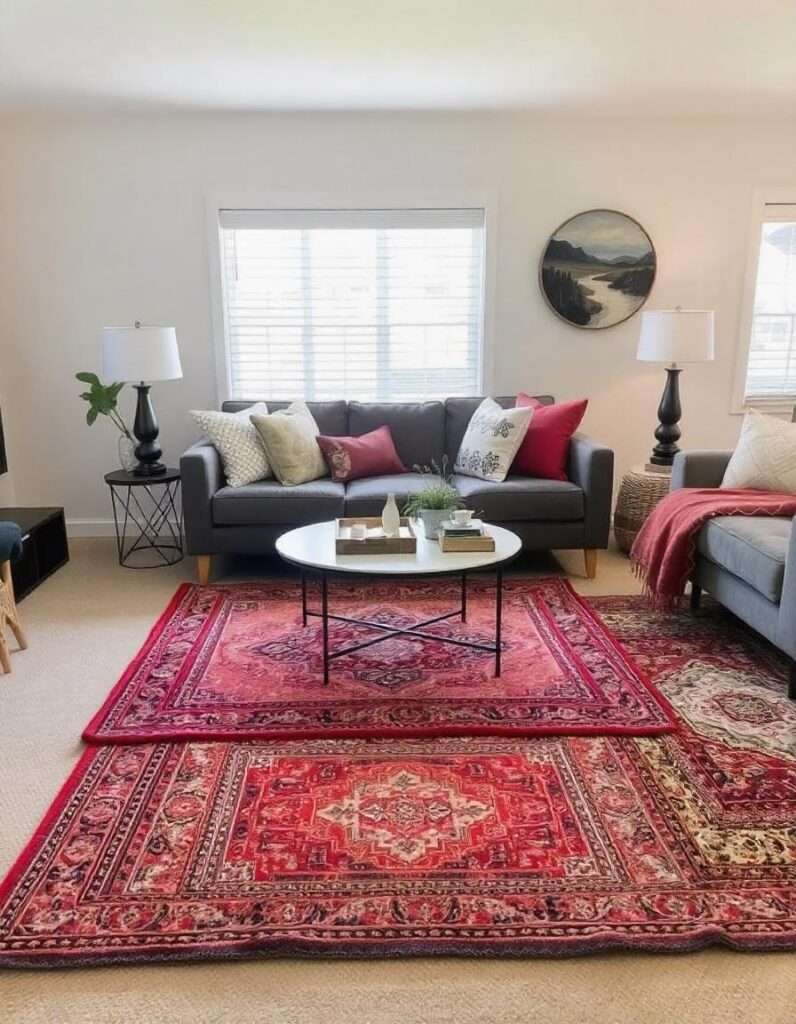
Rug layering is not a one-size-fits-all strategy. Each room presents unique challenges and opportunities for creating stunning floor designs that enhance both functionality and aesthetic appeal. This section will provide targeted guidance for layering rugs in specific areas of your home.
A. Living Room Layering: Creating Dynamic and Inviting Spaces
- Furniture Arrangement Strategies
- Anchor seating areas with strategically placed rugs
- Create visual boundaries without physical barriers
- Use rug layers to define conversation zones
- Layering Techniques for Living Rooms
- Start with a large neutral base rug
- Add smaller accent rugs with bold patterns
- Create depth through texture and color variations
“In the living room, rugs are not just floor coverings, they’re the foundation of your design narrative.” – Nate Berkus, Interior Design Innovator
Optimal Rug Layering Configuration
| Rug Placement | Room Size | Recommended Approach |
| Small Living Rooms | Under 200 sq ft | Minimal layering, single focal rug |
| Medium Living Rooms | 200-400 sq ft | Base rug + 1-2 accent rugs |
| Large Living Rooms | 400+ sq ft | Multiple layer combinations |
B. Bedroom Layering: Creating Comfort and Luxury
- Bed Positioning Techniques
- Layer rugs to extend beyond the bed frame
- Create soft landing areas on the sides
- Use runners for additional texture
- Comfort and Warmth Strategies
- Choose plush, soft materials for bedroom layers
- Consider thermal and vibrant properties
- Balance visual appeal with tactile comfort
Bedroom Layering Zones
- Base Layer: Large neutral rug under a bed
- Accent Layers: Smaller decorative rugs
- Functional Layers: Bedside runners
- Textural Layers: Sheepskin or textured additions
C. Dining Room Layering: Defining Elegant Dining Spaces
- Rug Size and Placement
- The rug should be big enough that comes out from chairs and tables
- Allow comfortable chair movement
- Protect underlying carpet from food spills
- Material Considerations
- Choose durable, easy-to-clean materials
- Consider stain-resistant fabrics
- Balance aesthetics with practicality
Dining Room Rug Sizing Guide
- Small Dining Tables: 5×7 ft base rug
- Medium Dining Tables: 8×10 ft base rug
- Large Dining Tables: 9×12 ft base rug
- Accent Layers: 2×3 ft decorative rugs
Professional Layering Tips
- Maintenance Strategies
- Use rug pads to prevent slipping
- Regular cleaning and rotation
- Address spills immediately
- Design Harmony
- Maintain color consistency
- Balance patterns and textures
- Consider overall room aesthetic
Emerging Trends in Room-Specific Layering
- Sustainable and eco-friendly materials
- Smart, technology-integrated rugs
- Customizable modular rug systems
- Cultural and artisanal design influences
Common Mistakes to Avoid When Layering Rugs on Carpet: Expert Preservation and Care Strategies
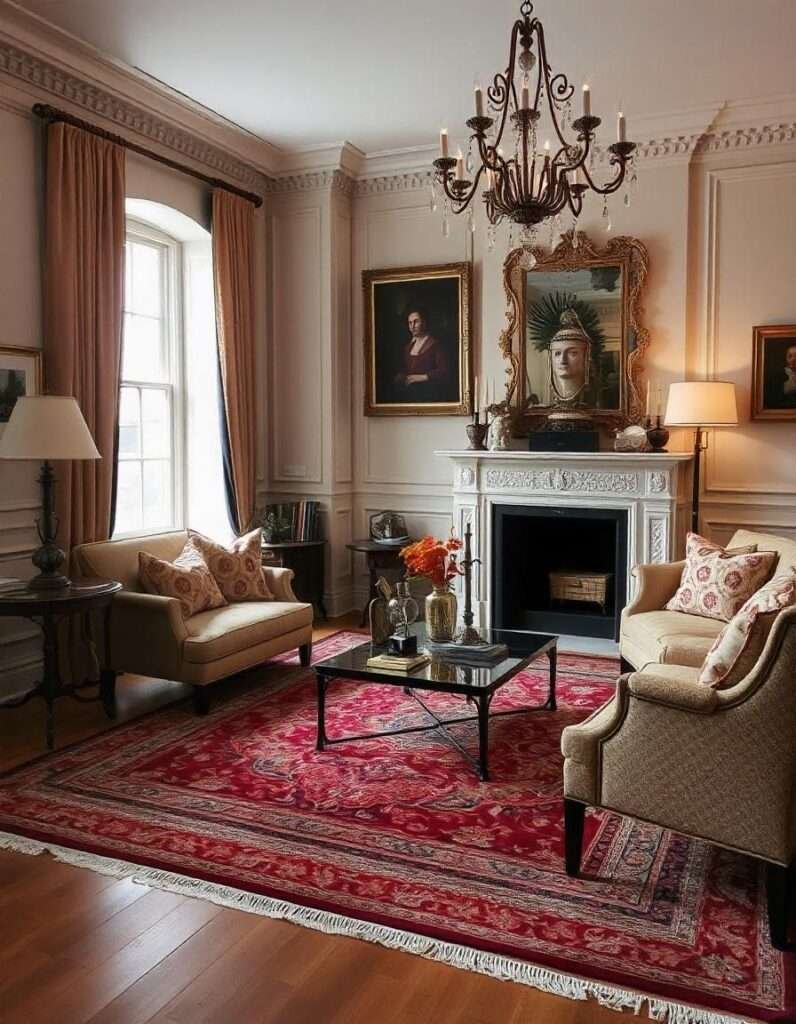
Understanding potential mistakes is crucial when learning how to layer rugs on carpet. This section will provide insights into common pitfalls, maintenance techniques, and preservation strategies that will help you protect your investment and maintain a stunning interior design.
A. Top Mistakes in Rug Layering Techniques
- Overcrowding and Visual Chaos
- Resist the urge to add too many layers
- Maintain negative space
- Follow the 2-3 layer maximum rule
- Prioritize intentional design over quantity
- Improper Sizing Catastrophes
- Avoid rugs that are too small or too large
- Maintain proper proportion with furniture
- Use the 12-18 inch border rule around room edges
“In design, less is often more. Rug layering is an art of restraint and precision.” – Kelly Wearstler, Interior Design Icon
Sizing and Proportion Breakdown
| Mistake | Consequences | Correct Approach |
| Undersized Rugs | Fragmented look | Use rugs that extend under furniture |
| Oversized Layers | Overwhelming space | Maintain a 70-30 base-to-accent ratio |
| Misaligned Rugs | Cluttered appearance | Align with the room’s architectural lines |
B. Comprehensive Maintenance Strategies
- Cleaning Techniques
- Regular vacuuming between layers
- Professional deep cleaning annually
- Use specialized rug cleaning tools
- Address spills immediately
- Moisture Management
- Prevent moisture buildup
- Use moisture-wicking rug pads
- Ensure proper air circulation
- Check for mold and mildew regularly
Rug Care Maintenance Checklist
- Weekly Tasks
- Vacuum all rug layers
- Shake out smaller accent rugs
- Check for loose threads
- Monthly Tasks
- Rotate rugs to ensure even wear
- Inspect for damage
- Clean rug edges and fringes
- Annual Tasks
- Professional deep cleaning
- Assess overall rug condition
- Consider rug replacement or restoration
Also Read: How to Keep Rugs Looking New Again: Easy Care & Tips
Advanced Preservation Techniques
- Protective Treatments
- Apply stain-resistant sprays
- Use fabric protectors
- Consider professional fabric treatments
- Storage Strategies
- Roll rugs, never fold
- Use acid-free tissue paper
- Store in cool, dry environments
- Avoid direct sunlight exposure
Technology in Rug Maintenance
Emerging innovations include:
- Smart fabric technologies
- Nano-coating for stain resistance
- Advanced cleaning robotics
- Sustainable preservation methods
Psychological Impact of Rug Maintenance
Research suggests that well-maintained living spaces:
- Reduce stress
- Improve mental well-being
- Create a sense of control
- Enhance overall home aesthetics
Key Takeaways
- Maintenance is an ongoing process
- Prevention is better than cure
- Invest time in proper care
- Understand your rugs’ specific needs
How to Layer Rugs on Carpet: Affordable Design Strategies for Budget-Conscious Decorators
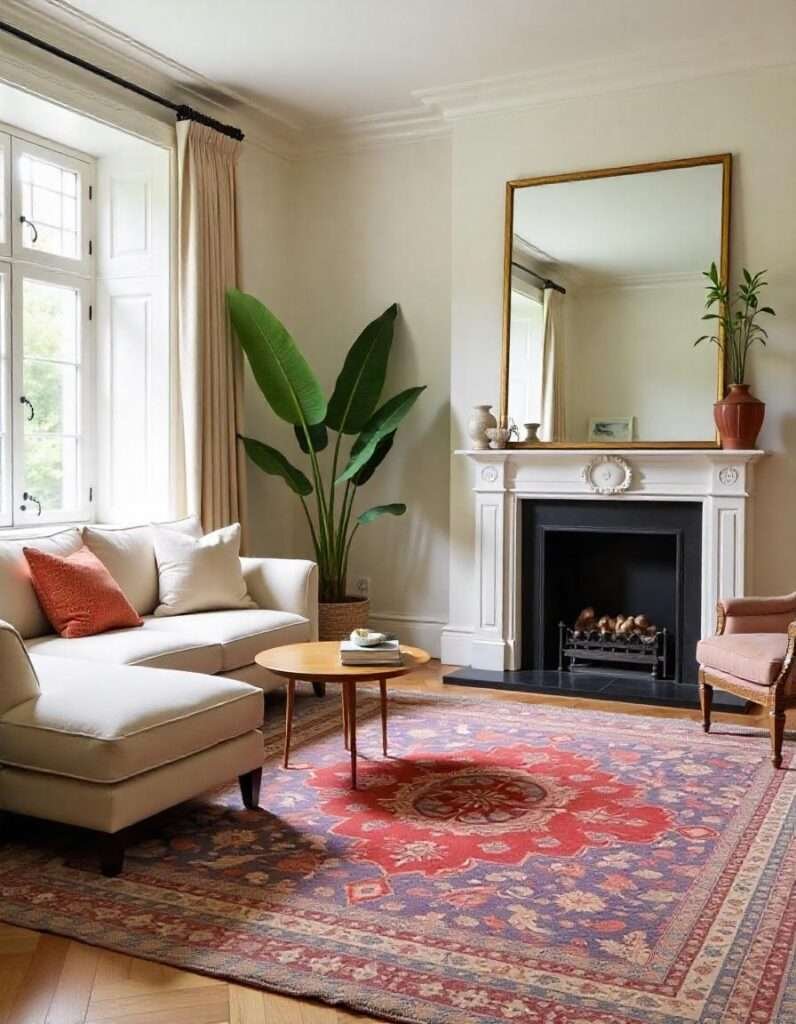
Transforming your space does not mean rendering you an empty pocket. This section will explore creative, cost-effective approaches to rug layering that prove great design is possible at every price point. Learn how to create stunning floor designs that are both economical and extraordinary.
A. Innovative Approaches to Affordable Rug Styling
- Thrift Stores and Second-Hand Discoveries
- Explore vintage and second-hand markets
- Look for unique, affordable pieces
- Mix high-end with budget-friendly finds
- Inspect carefully for quality and condition
- Online Marketplace Opportunities
- Utilize platforms like:
- Facebook Marketplace
- eBay
- Craigslist
- Local buy/sell groups
- Negotiate prices
- Look for bundle deals
- Utilize platforms like:
Budget Rug Sourcing Comparison
| Source | Average Cost | Pros | Cons |
| Thrift Stores | $10-$50 | Unique finds | Requires time/effort |
| Online Marketplaces | $20-$100 | Wide selection | Potential quality issues |
| Discount Retailers | $50-$200 | Consistent quality | Less unique |
| Wholesale Outlets | $30-$150 | Bulk savings | Limited design options |
B. DIY Rug Modification Techniques
- Creative Upcycling Methods
- Paint fabric rugs
- Add decorative borders
- Combine multiple smaller rugs
- Use fabric dyes for color refresh
- No-Sew Modification Tricks
- Use fabric glue for repairs
- Create custom designs with stencils
- Add fringe or decorative edges
- Patch worn areas creatively
Budget-Friendly Layering Techniques
- Layer Affordable Runners
- Use Carpet Remnants
- Mix Textures from Discount Stores
- Create Custom Combinations
Balancing Quality and Cost
- Long-Term Value Strategies
- Invest in high-quality base rugs
- Choose neutral colors for versatility
- Select durable materials
- Consider the cost per year of use
- Material Selection Guide
- Natural fibers: Wool, cotton
- Synthetic options: Polypropylene, nylon
- Blend materials for optimal performance
Emerging Budget-Friendly Trends
- Sustainable, recycled rug materials
- Modular, mix-and-match rug systems
- Digital print technologies
- Collaborative design platforms
Financial Planning for Rug Layering
- Base Rug: 60-70% of budget
- Accent Rugs: 20-30% of budget
- Accessories: 10% of budget
Psychological Benefits of Smart Spending
Research indicates that:
- Mindful spending reduces stress
- Creative solutions boost confidence
- Budget decorating enhances problem-solving skills
Key Takeaways
- Creativity trumps expensive purchases
- Quality matters more than quantity
- Be patient in your design journey
- Experiment and have fun
Emerging Trends in Rug Layering: Innovative Design Horizons and Future Predictions
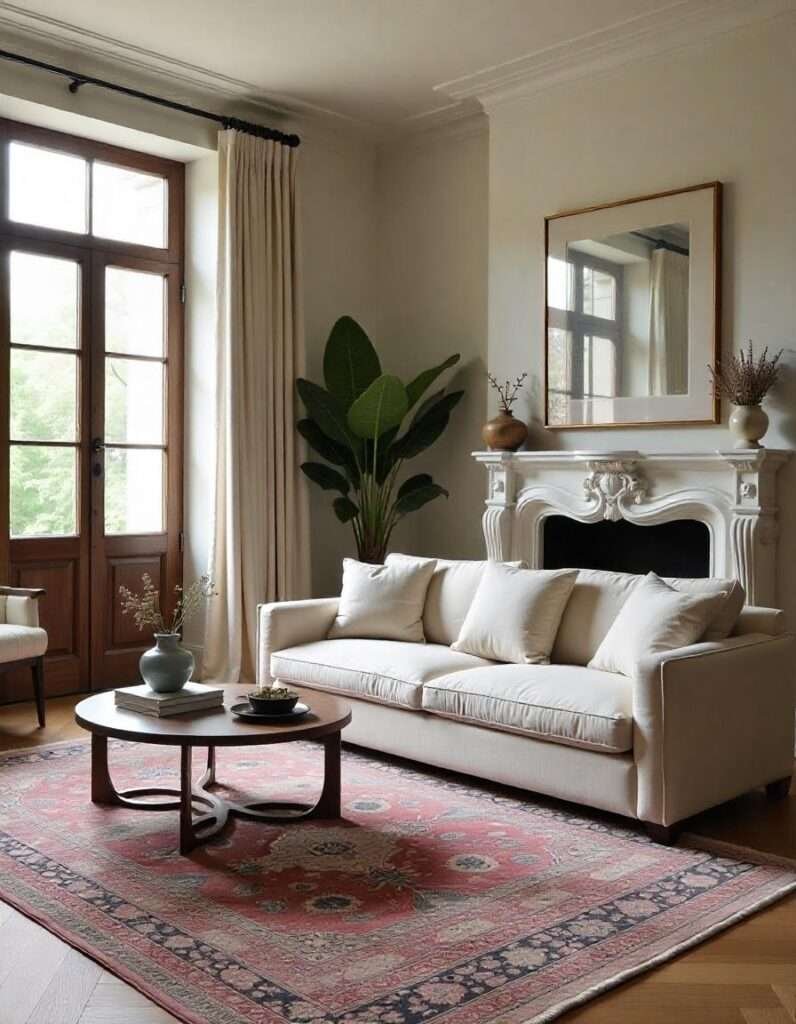
As interior design continues to evolve, rug layering stands at the intersection of technology, sustainability, and personal expression. This section delves into the most exciting trends and forward-looking predictions that will shape how we approach floor styling in the coming years.
A. Contemporary Design Movements
- Sustainable Material Innovations
- Eco-friendly fabric technologies
- Recycled and upcycled rug materials
- Biodegradable textile solutions
- Circular economy design principles
- Minimalist Layering Approaches
- Reduction of visual clutter
- Monochromatic color strategies
- Emphasis on texture over pattern
- Multifunctional design concepts
Sustainability Trend Breakdown
| Trend | Key Characteristics | Environmental Impact |
| Recycled Materials | Plastics, ocean waste | Reduces landfill waste |
| Organic Fibers | Natural, biodegradable | Minimal carbon footprint |
| Smart Textiles | Tech-integrated | Reduces material consumption |
| Modular Design | Adaptable, replaceable | Extends product lifecycle |
B. Technological Integration in Rug Design
- Smart Textile Innovations
- Temperature-regulating materials
- Moisture-sensing technologies
- Self-cleaning fabric technologies
- Embedded health monitoring sensors
- Digital Customization Platforms
- AI-driven design recommendations
- Virtual rug layering simulators
- On-demand custom printing
- Personalized design algorithms
Technological Features in Modern Rugs
- Wireless charging capabilities
- Climate adaptation technologies
- Color-changing smart fabrics
- Augmented reality design tools
Cultural and Global Design Trends
- Textile Cultural Exchange
- Global artisan collaborations
- Cross-cultural design inspirations
- Preservation of traditional techniques
- Ethical sourcing practices
- Multicultural Design Fusion
- Blending traditional and modern styles
- Celebrating cultural textile heritage
- Promoting design diversity
- Supporting global artisan communities
Future Prediction Insights
- AI-powered design personalization
- Fully sustainable production methods
- Advanced material science innovations
- Increased focus on wellness-driven design
Psychological and Social Implications
Research highlights that innovative design trends:
- Enhance emotional connection to living spaces
- Promote sustainable lifestyle choices
- Encourage creative personal expression
- Support mental well-being through the environment
Technological Investment Considerations
- Research & Development: 40%
- Sustainable Materials: 30%
- Manufacturing Innovation: 20%
- User Experience: 10%
Key Takeaways
- Design is continuously evolving
- Technology enhances human creativity
- Sustainability is paramount
- Personal expression remains crucial
Final Thoughts: Mastering the Art of Rug Layering on Carpet
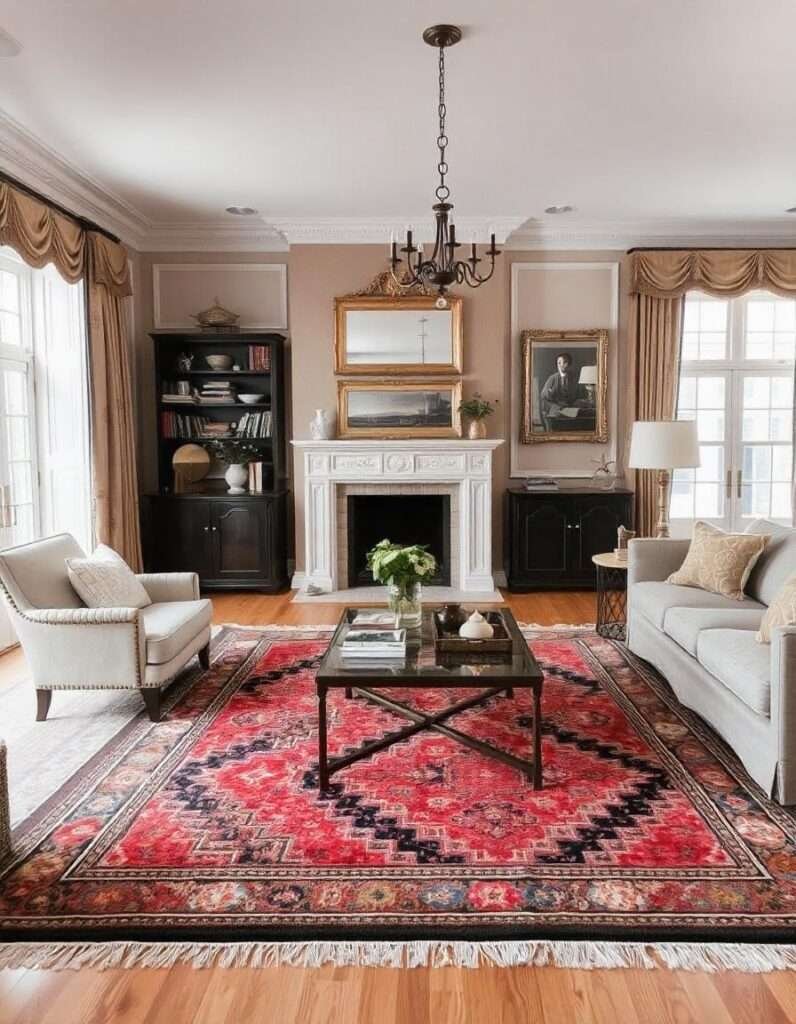
As we conclude our comprehensive journey through the world of rug layering, it’s time to synthesize the key insights, empower your design decisions, and inspire you to transform your living spaces with confidence and creativity.
The Holistic Approach to Rug Layering
Rug layering is more than a design technique. It’s a form of personal storytelling. Each layer represents a choice, a moment, a memory. From the practical considerations of texture and placement to the emotional resonance of color and pattern, your rugs are a canvas of personal expression.
Key Insights Recap
- Design Principles
- Understand color theory
- Master texture combinations
- Respect room-specific requirements
- Prioritize functionality
- Practical Considerations
- Invest in quality materials
- Maintain your rugs carefully
- Experiment with layering techniques
- Balance aesthetics and practicality
“Great design is not about perfection, but about telling a story that resonates with you.” – Joanna Gaines, Design Innovator
Future-Forward Design Strategy
- Technological Integration
- Stay informed about smart textile technologies
- Explore sustainable material innovations
- Consider the long-term environmental impact
- Personal Growth Through Design
- View each design choice as a learning opportunity
- Be open to experimentation
- Trust your creative instincts
Strategic Investment Principles
- Quality over quantity
- Prioritize versatile pieces
- Plan for long-term value
- Support ethical and sustainable practices
Your Design Empowerment Manifesto
- Embrace Creativity
- There are no strict rules in design
- Your space, your rules
- Confidence is the best accessory
- Continuous Learning
- Stay curious
- Follow design trends
- Attend workshops
- Engage with design communities
Final Thoughts: Your Design Journey
Rug layering is a metaphor for life layered, complex, and beautiful in its imperfections. Each choice you make is an opportunity to create something uniquely yours.
Call to Action
- Start small
- Experiment fearlessly
- Document your design journey
- Share your creations
- Celebrate your unique style
